Sacred Signs : 4
Sacred Signs : 4
Naming
The King’s Name
As the most important person, the King had five names in order to show his relationship to the gods and define his divine credentials.
His oldest name is the HORUS name, written with the falcon of Horus standing upon a rectangular box called a serekh. The serekh was originally shown with a niched façade and seems to have been a representation of the king’s palace.
His Second name is HORUS OF GOLD, written with a Horus falcon upon the hieroglyph for gold. This name may be connected to the domination of Horus over Nubt (Naqada) sometime in prehistory and replace the more contentious Horus and Seth name.
 | 4.1 (left) In the centre column of text, reading from right to left and down, there is the Horus name of Ka-nakht-en-Re ‘Strong Bull of Re’, Two Ladies, Itj-tau-nebu ‘One who seizes all of the lands’, Horus of Gold, Hu-Pesedjtyu ‘He who smites the Nine Bows’. This is from the obelisk of Tuthmosis I at Karnak and the text contains the abbreviated versions of these names. The third name is the TWO LADIES name. This is written with a cobra and a vulture sitting in (shown as upon) baskets. The cobra represents Wadjyet, the protective goddess of Lower Egypt and the vulture is Nekhbet, the protective goddess of Upper Egypt. The title shows that the king is protected by the goddesses of the two lands he rules. |
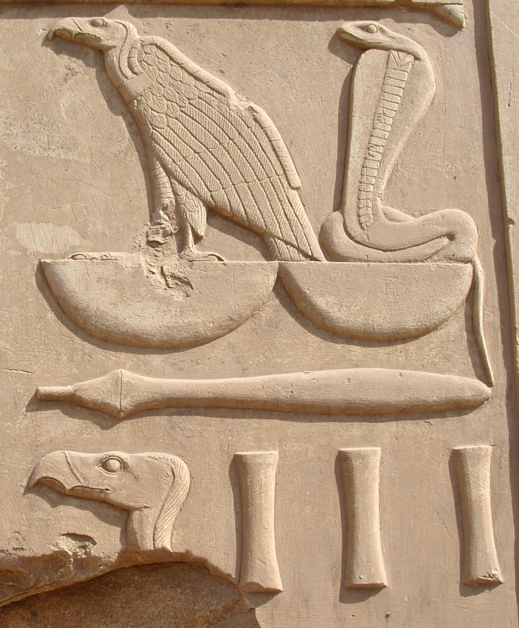
4.2 This exquisitely carved version is the Two Ladies name of Amenhotep I aa-neru ‘Great of Fear’ (reading from left to right and down). It is in the Open Air Museum at Karnak.The fourth name is the SON OF RE name, written with a goose hieroglyph for the word for ‘son’ and the sun disk to represent Re, the sun god. This is used from the 4th Dynasty and shows that the king is regarded as the direct son of the sun god Re.
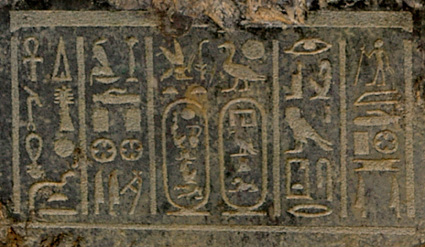
4.3 This is from a sphinx at Buto. In the centre, the two final names of the king face each other. To the right there is the Son of Re name followed by a cartouche underneath (reading left to right and down) with the name Hakor. To the left (reading right to left and down) is the nesu-bity name Khenem-maat-Re Setep-en-Khnum.
The rest of the text are other titles:
right: (Hakor) is beloved of Osiris in the Mansion of the Official in Dep (a temple of Osiris in Buto).
left: (Khenem-maat-Re Setep-en-Khnum) is beloved of Wadjyet of Pe and Dep (places in Buto), given life, stability, power like Re forever.
Hakor was a king of Dynasty 29.
The fifth name is the NESU-BITY name, written with a reed and a t-sign and a bee and t-sign. The name means King of Upper Egypt and King of Lower Egypt and reaffirms the king as ruler of the two parts of Egypt.
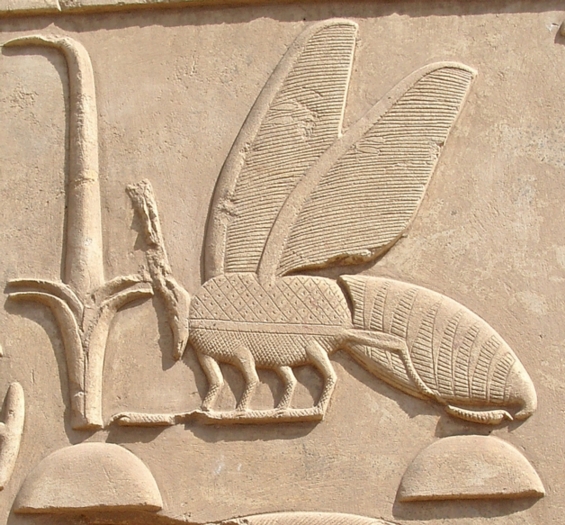
4.4 Another carving of Amenhotep I from Karnak, showing the detail of the bee-sign.
Pharaoh
The word Pharaoh is derived from another name sometimes given to the king later in Egyptian history. A word used for the king in the New Kingdom was per-aa, meaning ‘Great House’ and referring to the Palace of the king and the king himself as the institutional power and representative of it. The name is written with the house sign (per) and the door-leaf (aa). It can be used as a title of the king and written in a cartouche, especially in the Ptolemaic period.

4.5 This is from the temple of Dakke, built mainly during the Ptolemaic and Roman periods.
In this scene a king makes an offering of his own name and a scribe’s palette. The two cartouches are upon a scribe’s palette, to show that they are written, and it is in turn raised by a figure for millions and an adoring godddess (?).
The cartouches are introduced as: (right) King of Upper and Lower Egypt, Lord of the Two Lands Per-Aa ‘Pharaoh’
(left) King of Upper and Lower Egypt, Lord of Glorious Appearances Pharaoh.
Negative Aspects of Hieroglyphs and Inscriptions
Something can be identified as dangerous and then nullified by the manner in which its name is written. This at once prevents the dangerous object from causing harm as well as ensures its permanent disablement.
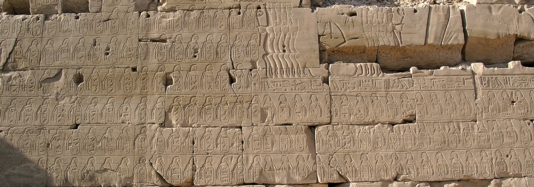
4.6 These cartouche-like rings contain the names of foreign cities which have been subdued and captured by the Pharaoh Shoshenq I and depicted on the Bubastite Portal in Karnak Temple. The names of the cities in Palestine are written carefully in hieroglyphs keeping to their exact pronunciation. However, their potential for causing harm has been nullified by depicting the name of the city as the body of an enemy-prisoner figure whose head and arms bound behind the body are clearly shown. This kind of writing ensures that the hostile forces are kept bound like prisoners.
Whole pieces of images and text can be erased in order to prevent individuals from carrying out their duties, even if they are royal rituals.
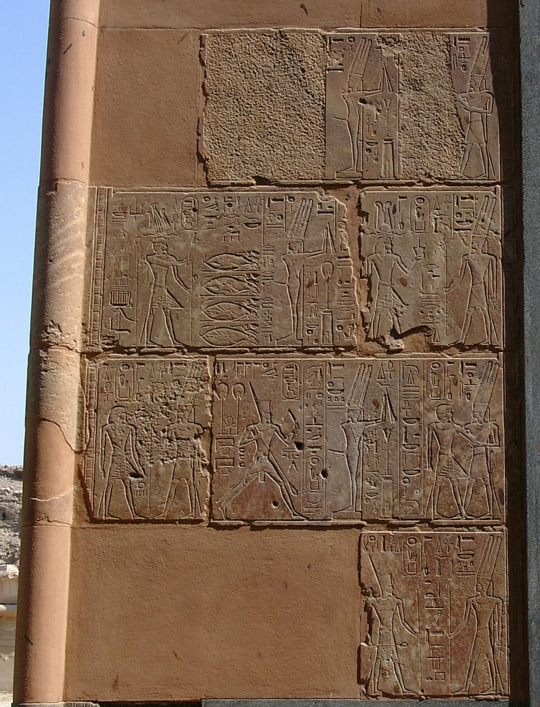
4.7 The texts are part of the Black & Red Chapel of Hatshepsut now reconstructed at Karnak. The chapel was a barque station for use during the great festivals held at Karnak in honour of Amun. It shows scenes from the rituals performed by Hatshepsut in her role as king. The sequence of blocks shows Hatshepsut before Amun, but in the upper register of scenes the figure of the king and the texts describing her and her actions has been completely erased. This action must have been intended to ensure that Hatshepsut could not carry out the rituals depicted. However the erasures do not seem to have been systematic because she can still be seen in the other blocks. They may have been reused in other buildings and this would have been just an effective method of keeping her from her duties.
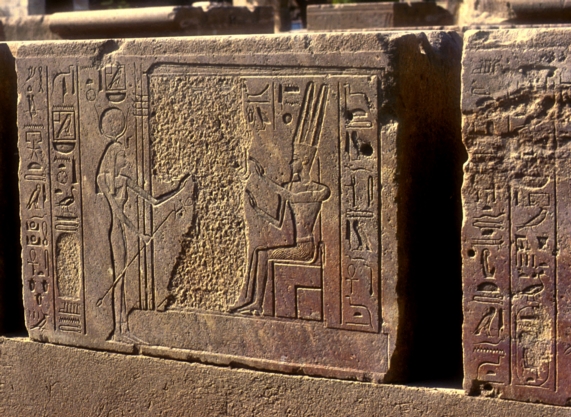
4.8 In this block where the figure of Hatshepsut was once shown inside a shrine receiving the direct blessing of Amun-Re, the figure and names of the king have been completely erased, leaving the goddess Hathor to the left and Amun-re to the right facing each other. The cartouche of the king on the left has also been removed and the cartouche upon the right hand block has been attacked.
Luxor Architraves
The upper architraves of the columned courtyard in Luxor temple show signs of the erasure of names and then their reinstatement at a later date.

4.9 In the bottom line of the text, the figure of the goddess Maat within the king’s cartouches has been defaced, perhaps suggesting that divine images could not be represented in human form. To the right of the cartouche, the name of the god Amun has been erased.
In the centre register, the cartouche contains the name of Amenhotep Ruler of Iun (Amunhotep III). The cartouche seems to have been erased and, then, at a later stage reinstated with the erasures having been partially smoothed down and the name of the king reinscribed.
In the top register the figure of the goddess in the cartouche remains untouched. Perhaps the people who had been sent to carry out the work missed this hieroglyph, or could not reach it.
Philae Door Jamb
The temple of Isis at Philae was converted into a Christian church in the 5th century AD. Aside from some architectural changes within the temple, some Christian motifs were added to figures, both to de-paganise them and to state the Christian conversion of the building.
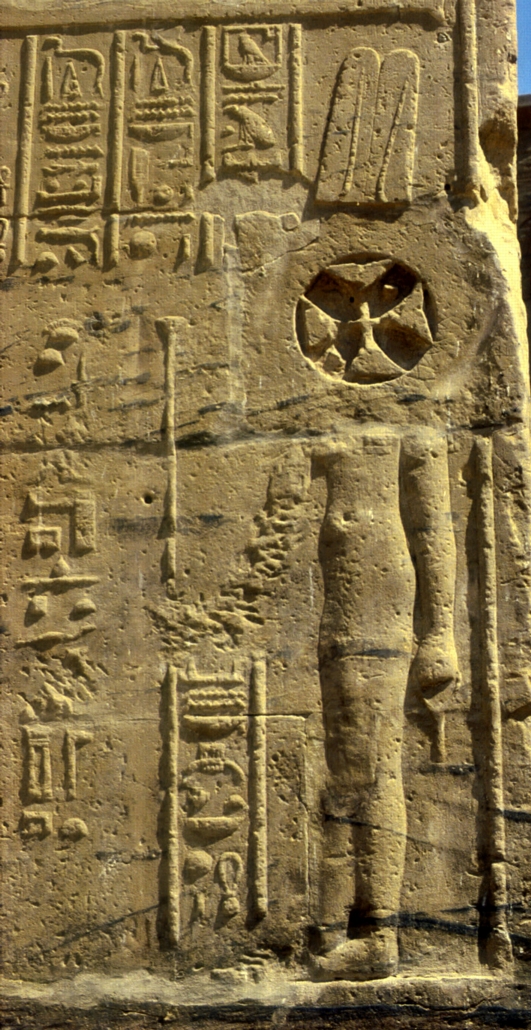
4.10 On this door jamb on the main axis into the temple, the figure of Isis has been defaced by a cross.
Cryptic Texts

4.11 Crocodile text.
This text from high inside the front of the hypostyle hall of the Temple of Esna is written almost completely in crocodile hieroglyphs.
The text is written in columns and reads from left to right. It begins with the word:
iaw ‘Praise’ and this alerts the reader to the fact that it is a hymn of praise. The crocodile words in the main body of the text are the multiple names and epithets of the crocodile god Sobek. For example, four crocodiles down on the left hand column there is a word written with the head of a vulture and three plural strokes. This could be the word nrw for ‘fear’ and so we may read: the crocodile is read as nb, meaning ‘Lord’ with nrw, and together they are ‘Lord of Fear’, one of the epithets of Sobek. The vulture head can also read rmT, the word for ‘people’, and so something like ‘Lord or Ruler of people’.
The great French scholar Serge Sauneron, suggested that this was a hymn to Khnum along with the symmetrical text opposite, written almost entirely in ram hieroglyphs (S. Sauneron, Esna VIII L’écriture figurative dans les textes d’Esna, IFAO, Cairo, 1982).
